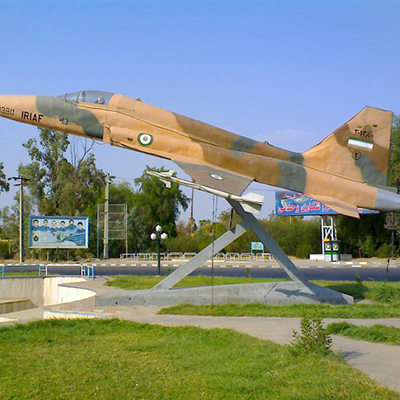Sites
Fourth Tactical Fighter Base (Vahdati)
Written by: Mohsen Shirmuhammad
Translated by: Hadi Qorbanyar
21 Views
The Fourth Tactical Fighter Base of Vahdati is located in northern Khuzestan, west of the city of Dezful. It was among the most significant military installations in Khuzestan Province during the Sacred Defense.
The history of Vahdati Base dates back to World War II, when a military facility was constructed in Dezful by Allied forces to support the Soviet Union. After the Allies’ withdrawal, the base was handed over to the Iranian Army. In 1956, preparations began to establish an air base at the location. Within two years, some parts of the base were completed, and on November 26, 1959, the first group of jet aircraft belonging to the Iranian Air Force landed at the base. With construction completed two years later, the base was formally transferred to the Iranian Army Air Force.[1]
In early 1961, the name of Dezful Base was formally changed to Vahdati, in honor of two Air Force pilot brothers who had lost their lives in separate aviation incidents.[2] Initially, F-84 fighter jets were stationed at the base, followed by F-86 aircraft.[3] Beginning in 1968, Vahdati Base began receiving more advanced F-5 fighter jets to replace the aging F-86 fleet. By early 1971, all F-5 aircraft had been delivered to the base.[4] Later on, with the construction of new military facilities across the country, the Vahdati Base was reclassified under the Air Force’s new organizational structure as the Fourth Tactical Fighter Base of Vahdati.[5]
By September 1980, Vahdati Base housed 76 F-5 fighter jets and 63 pilots.[6] With the onset of Iraq’s invasion, the base played a critical role in confronting the enemy. Combat operations began in September 1980 following Iraq’s border incursions. On September 18, 1980, pilot Muhammad Zare-Nemati was martyred during an aerial engagement with Iraqi forces in the southern border region of Fakkeh, after his aircraft was targeted. On the same day, Hussain Lashgari was captured following an aerial confrontation near Mehran, in a territory under enemy control, after his aircraft was shot down. He was released 18 years later.[7]
On September 23, 1980, Iran launched its first large-scale military response through Operation Alborz, known as Kaman 99. A total of 343 sorties were flown during this operation, including 217 cross-border missions and 128 ones involving armed aerial patrols, close air support, and reconnaissance. Vahdati Base conducted 55 cross-border combat missions.[8]
During the early stages of the war, the Iranian Army Air Force used Vahdati Base mainly to disrupt Iraqi advances in northern Khuzestan. These missions targeted Baathist army units west of the Karkheh River and focused heavily on the Dezful region. The operations came at a high cost to the Air Force: five F-5 fighter jets were destroyed, and five pilots were martyred.
During this roughly forty-day period, Iraqi troops carried out repeated attacks to cross the Naderi Bridge and the Karkheh River, hoping to seize Shoush and Andimeshk and cut off Khuzestan’s logistical artery. Such an action would have significantly disrupted Iran’s capacity to deliver reinforcements and logistical support to the region. Consequently, the Iranian military leadership gave priority to defending this corridor.[9] Therefore, Iranian pilots conducted numerous bombing missions to prevent enemy forces from crossing the Karkheh River. In the meantime, the Fourth Tactical Fighter Base itself was constantly targeted by airstrikes, shelling, and missile fire. Due to the base’s close proximity to the frontlines, the flight time from Vahdati to target zones was often only a matter of minutes.[10] Despite these challenges, the sustained efforts of Iranian forces ultimately led to the containment and immobilization of invading troops in northern Khuzestan by October 31.[11]
With the war dragging on, Vahdati Base took an increasingly active role in providing air support for major operations aimed at expelling Iraqi forces from Khuzestan. Notably, during Operation Thamen al-Aemmah (as) (the breaking of the siege of Abadan in September 1981), the base deployed 41 and 42 fighter squadrons. Furthermore, in Operation Tariq al-Quds (liberation of Bostan and western Khuzestan in November-December 1981), it contributed one interceptor squadron and one F-5 fighter-bomber group. Also, the Vahdati Base took part in Operation Beit al-Muqaddas (liberation of Khorramshahr and southwestern Khuzestan in April-June 1982), through the deployment of F-5 aircraft from Squadron 41.[12]
During the Imposed War, Vahdati Base lost more pilots than any other Iranian air base, making up 65 percent of all aircraft losses.[13] Among its distinguished martyrs during the Sacred Defense are Touraj Yousef, Seyyed Shahabeddin Tabatabaei, Firooz Sheikh-Hassani, Gholamhussain Orooji, Changiz Sepehr, Nasrollah Asil-Adab, Hussain Bahram, Hadi Jouriki, Mansour Nazerian, Muhammad-Ali Farzin, Hamid Fazilat, Muhammad Zare-Nemati, Kambakhsh Ziaei, Hussain Muqimi, Jahanbakhsh Mansouri, Mostafa Mortezaei, Fath-Ali Gholamrezaei, and Asghar Sadri-Noushad.[14]
The base hospital also played a vital role during the war, providing medical care to injured members of the armed forces and facilitating their transfer to other treatment centers. Between September 22, 1980, and the end of the war, over 19,000 injured personnel were treated at the hospital.[15]
Throughout the Sacred Defense, command of Vahdati Base was successively held by Muhammad-Reza Tabesh-Fard, Abbas Abedin, Ali Gilani, Ali Rezvani, Seyyed Esmaeil Mousavi, and Habib Baqaei. The current commander is Brigadier General (Second Class) Pilot Javad Valadi.[16]
Vahdati Base remained active and operational after the war, and its facilities and equipment underwent restoration. As part of Project Azarakhsh—focused on the modernization of F-5 fighter jets—a number of aircraft were refurbished and enhanced. Today, Vahdati Base remains the most important air base in Khuzestan Province, operating three tactical and training squadrons of F-5 fighter aircraft.[17]
Since 2002, the base has hosted the Rahian-e Noor Air Exhibition every Nowruz, with aircraft and helicopter displays, aviation technology exhibits, and live F-5 jet performances.[18]
[1] Namaki, Ali-Reza va Hussain Khalili, Tarikh-e Nabardhaye Havaei-ye Defa Muqaddas – Jang ba Tankha (The History of Aerial Battles of the Sacred Defense – The War with Tanks), Vol. 5, Tehran, Markaz-e Entesharat-e Rahbordi-ye NAHAJA, 1396, Pp. 31–32.
[2] Tolouei, Morteza, Tarikh-e Nirooye Havaei-ye Shahanshahi – Az Afsane ta Haqiqat (The History of the Imperial Air Force – From Myth to Reality), Tehran, Setad-e Farmandehi-ye Nirooye Havaei, 1355, p. 52.
[3] Ibid., p. 32.
[4] Dehbashi, Hussain, Farmandehi va Nafarmani – Khaterat-e Sepahbod Khalaban Shapour Azarbarzin (Command and Disobedience – Memoirs of Air Force Lieutenant General Shapour Azarbarzin), Tehran, Sazman-e Asnad va Ketabkhaneh-ye Melli-ye Iran, 1393, Pp. 37–38.
[5] Namaki, Ali-Reza va Hussain Khalili, Ibid., p. 32.
[6] Goruh-e Moallefin-e Tarikh-e Defa Muqaddas-e Havaei, Tarikh-e Nabardhaye Havaei (The History of Aerial Battles), Vol. 1, p. 391.
[7] Shirmuhammad, Mohsen, Paydari-ye Vahdati – Tarikh-e Paygah-e Chaharom-e Shekari-ye Dezful (Unity and Resistance – The History of Dezful’s Fourth Tactical Air Base), Vol. 1, Tehran, Markaz-e Entesharat-e Rahbordi-ye NAHAJA, 1401, Pp. 105–110; Goruh-e Moallefin-e Tarikh-e Defa Muqaddas-e Havaei, Tarikh-e Nabardhaye Havaei (The History of Aerial Battles), Vol. 1, Tehran, Markaz-e Motaleaat-e Rahbordi-ye NAHAJA, 1393, Pp. 312–318.
[8] Heyat-e Tadvin-e Tarikh-e Defa Muqaddas, Taqvim-e Mostanad-e Amalkard-e Nirooye Elahi-ye Havaei-ye Artesh-e Jomhouri-ye Eslami-ye Iran (Documented Calendar of the IRI Air Force Performance), Mehr 1359, Vol. 3, Tehran, Markaz-e Entesharat-e Rahbordi-ye NAHAJA, 1397, p. 63.
[9] Shirmuhammad, Mohsen, Ibid., Pp. 14–15; Namaki, Ali-Reza, Nirooye Havaei dar Defa Muqaddas (The Air Force in the Sacred Defense), Tehran, Iran Sabz, 1389, p. 161.
[10] Shirmuhammad, Mohsen, Ibid., Pp. 14–15.
[11] Ibid., p. 15.
[12] Namaki, Ali-Reza, Ibid., Pp. 177, 178, 212 and 251.
[13] Taqvaei, Babak, Paygah-e Vahdati va Gozaresh-e Tasviri-ye Namayeshgah-e Havaei-ye Rahian-e Noor (Vahdati Air Base and the Photo Report of the Air Exhibition of Rahian-e Noor), Mahnama-ye Sanaye-e Havaei, No. 249, Ordibehesht 1391, p. 49.
[14] Shirmuhammad, Mohsen, Ibid., Pp. 425–429.
[15] Muhammadzadeh Salahshour, Majid, Atlas-e Jame-e Naqshe-ye Edareh-ye Behdasht, Emdaad va Darmane NAHAJA dar Defa Muqaddas (Comprehensive Atlas of the Air Force Medical, Relief, and Treatment Administration’s Role in the Sacred Defense), Tehran, Soreh Sabz, 1395, p. 52.
[16] Khabargozari-ye Tasnim, 6 Mordad 1400, Farmandeh-ye Jadid-e Paygah-e Havaei-ye Dezful Mansoub Shod (The New Commander of Dezful Air Base was Appointed), www.tasnimnews.com/fa/news/1400/05/06/2545370
[17] Taqvaei, Babak, Ibid., Pp. 49–50.
[18] Ibid., p. 45.





